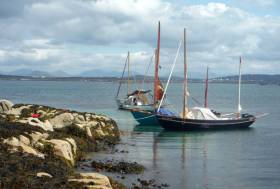Displaying items by tag: Rosamhil
€25 Million Deepwater Quay Will Regenerate Connemara Port of Ros-a-Mhíl
A 25 million euro deepwater development of the Connemara fishing port of Ros-a-Mhíl is due to be announced today by Minister for Marine Charlie McConalogue.
Construction of a 200-metre deepwater quay at the State-owned harbour and island ferryport may also position Ros-a-Mhíl as a strategic hub for the floating offshore wind sector with potential for 900 jobs.
The project will bring the Connemara harbour “closer in line” with the leading fishing ports of Killybegs in Donegal and West Cork’s Castletownbere.
Planning permission has already been secured, and construction is expected to take 28 months to complete.
McConalogue is bringing a memo to Cabinet on the project before meeting the Ros-a-Mhíl community this evening.
 Minister for Marine Charlie McConalogue
Minister for Marine Charlie McConalogue
The approval is the result of a campaign lasting over 20 years, spearheaded by the Aran and Connemara fishing industry and supported by Fianna Fáil Galway West TD Éamon Ó Cuív.
Ó Cuív said he hoped it would regenerate employment in fish processing, which has suffered due to lack of infrastructure for larger vessels.
Just under 90 per cent of all fish landed into Ireland came through the State’s fishery harbours in 2020, and Ros-a-Mhíl’s landings were primarily from Irish vessels and valued at €7 million in that same year.
The deep-water quay for the harbour – which is also a ferry port for the three Aran islands – will add 200 metres of quayside and provide greater depth to accommodate larger fishing vessels
Ó Cuív predicted it would also be a “game changer” for supporting offshore renewable energy in the west, which he described as “the ultimate oil well”.
A report commissioned by State agency Údaras na Gaeltachta noted that the Connemara harbour was “unique among ports on the Irish west coast in having existing permission for infrastructure ... to support the floating offshore wind project pipeline”.
The report by Dublin Offshore Consultants was presented to McConalogue in Ros-a-Mhil last October,
An additional four hectares of State-owned land with “laydown/development potential” will be added to the harbour centre as part of the works.
Údaras na Gaeltachta owns an additional 30 acres adjoining this four hectares which will be key to developing an offshore renewable energy hub.
Early signs of market intent for offshore wind in the region have been demonstrated by Green Investment Group’s recent acquisition of the 400MW Sceirde Rocks offshore wind farm off the Connemara coast.
The Marine Renewables Industry Association has said that new port capacity would be required in the west, in addition to Galway and Shannon Foynes, and it has identified Ros-a- Mhíl as “the obvious candidate”.
Procurement for the detailed design of the quay at Ros-a-Mhíl will be followed by a tender for construction later in the year, and the projected €25 million cost excludes VAT.
McConalogue has said the exact costing will only be clear when detailed design work is complete and an open tendering competition has taken place.
The project will be funded under the fishery harbour centres and coastal infrastructure development programme.
Ros-a-Mhíl Could Be "Strategic Hub" for Floating Offshore Wind with Potential for 900 jobs - New Report
The south Connemara harbour of Ros an Mhíl could become a strategic hub for the floating offshore wind sector with potential for 900 jobs, according to a new report.
The report, commissioned by Údarás na Gaeltachta and presented to Minister for Marine Charlie McConalogue today, was carried out by Dublin Offshore Consultants.
It identifies what is described as “a major opportunity for the Galway Gaeltacht and the wider economy” that could “revitalise the west coast from Clare’s Loop Head to Mayo’s Béal an Mhuirthead.
Ros a Mhíl does not currently have the capacity to support large scale offshore construction activities, the report says.
"Ros a Mhíl is “unique among ports on the Irish west coast in having existing permission for infrastructure"
However, it says planning permission granted to the Department of Agriculture, Food and the Marine (DAFM) in 2018 for a 200m deepwater quay “provides opportunity to develop the necessary onshore infrastructure”.
Ros a Mhíl is “unique among ports on the Irish west coast in having existing permission for infrastructure with the potential to support the floating offshore wind project pipeline”, it says.
The report identified possible scenarios, namely:
Ros an Mhíl has the potential to be a strategic hub with an important role to play in supporting the “significant pipeline of floating offshore wind on the Irish west coast;
The proximity of Ros an Mhíl to offshore project locations, and its potential deep berth, provide the opportunity for the cost-effective and timely entry into the offshore energy market;
Based on servicing 3GW of projects, this has the potential to result in up to 900 direct and indirect jobs for the region;
Ros an Mhíl benefits from a significant land bank adjacent to the proposed 12m deep-water berth, under the ownership of both Údarás na Gaeltachta and the Department of Agriculture, Food and the Marine;
Early signs of market intent for offshore wind in the region have been demonstrated by Green Investment Group’s recent acquisition of the 400MW Sceirde Rocks offshore wind farm off the Connemara coast;
A key component of Údarás na Gaeltachta’s strategic plan 2021 – 2025 is the “Green Gaeltacht”. Developing Ros an Mhíl as a strategic support hub for the offshore wind industry will “go a long way in supporting this initiative”, it says, and has been long identified by the authority as a strategic resource, where there are feasible opportunities for the harbour to be a strategic national centre for marine renewable energy.
Údarás na Gaeltachta is “working hand in hand with the community and the harbour development committee” to ensure that the harbour will have the opportunity to “attain every possible benefit from this sector in future” and that the appropriate basic infrastructure is available in the area to that end.
Welcoming the publication, Mr McConalogue thanked Údarás na Gaeltachta for its “foresight in having this report available to contribute to the deliberations on the future direction of investment at Ros an Mhíl”.
“There is a broad context here of cross-cutting Government policies and I understand that Údarás will take this report forward with their minister so that there can be a rounded consideration of the policy issues and investment needs raised,” he said.
Údaras na Gaeltachta chair Anna Ní Ghallachair and its chief executive officer Mícheál Ó hÉanaigh also welcomed the publication.
Marine Renewables Industry Association (MRIA) chair Peter Coyle said “the enormous wind and wave energy resource off the west coast should drive major new income and job creation in the area over the next twenty years”.
“Key to exploiting this opportunity is port facilities. The MRIA has long held the view that new port capacity will be required in the west - over and above the well-regarded ambitions of Galway and Shannon Foynes - and Ros an Mhíl is the obvious candidate with its deep water, land availability, geographical advantage and the support of Údarás na Gaeltachta,” he said.
Simply Blue Group director of stakeholder liaison and external affairs Brian Fitzgerald said that “as developers of the Western Star floating offshore wind project off the Clare coast, Simply Blue Group are passionate about the opportunities this brings for the west coast of Ireland”.
“Key to unlocking this potential is the need to have strategically located ports, to support the development of local supply chains,” he said.
“Assessment of the Technical, Environmental and Socio-Economic opportunities and constraints for Ros an Mhíl port considering the proposed development of Floating Offshore Wind (FOW) on the west coast of Ireland” is available here
Galway Bay Can Make it Happen While Other Places Wait for Development to Come to Them
Irish sailors don’t need their attention mesmerized by the horses and people clattering around the Galway Races Week to be well aware that in sailing matters too, it’s not a question of whether or not the West’s awake writes W M Nixon. On the contrary, you’d wonder do the hyper-energetic sailors around Galway Bay ever sleep as they implement one bright new idea after another, for these days the coastal facilities are being developed at a pace which few other popular sailing areas can match.
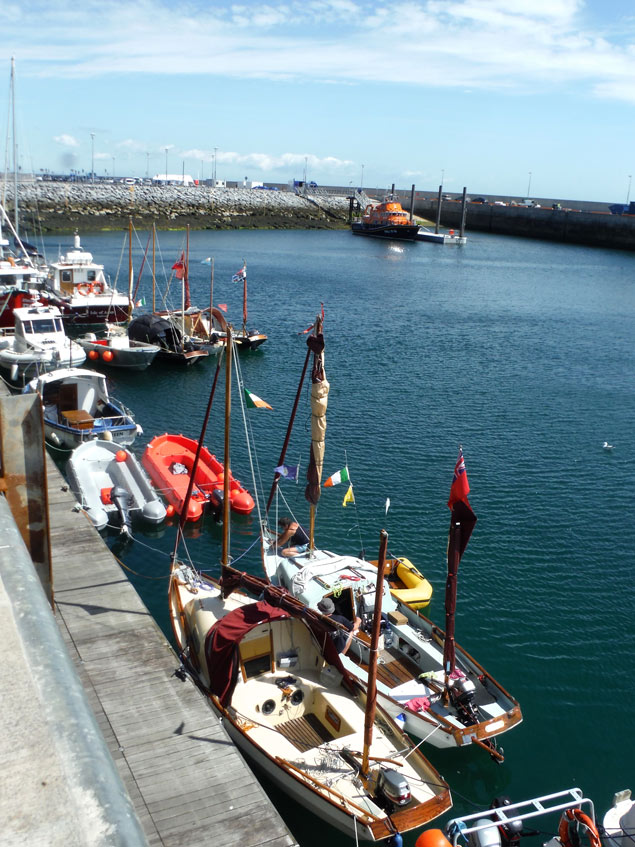 Just a week after the WIORA fleet had been in town, the Drascombe flotilla were one of the first cruising groups to use the new pontoons at Kilronan on Inishmore. Photo: Jack O’Keeffe
Just a week after the WIORA fleet had been in town, the Drascombe flotilla were one of the first cruising groups to use the new pontoons at Kilronan on Inishmore. Photo: Jack O’Keeffe
Until recently in southeast Connmemara, Rosamhil (or Rossaveal as the East Coast might know it) was mainly thought of as a busy fishing port and the ferry port for the Aran Islands. But a while back, it acquired a 34-berth marina which has proven so popular that in October this year the Harbour Master, Captain John Donnelly, will be overseeing the official opening of a brand new facility, a fully-serviced 160-berth marina which will be attractive both to locals and those from further afield and abroad who are taken with the notion of berthing their boats on the threshold of some of the most enchanting sailing waters in the world.
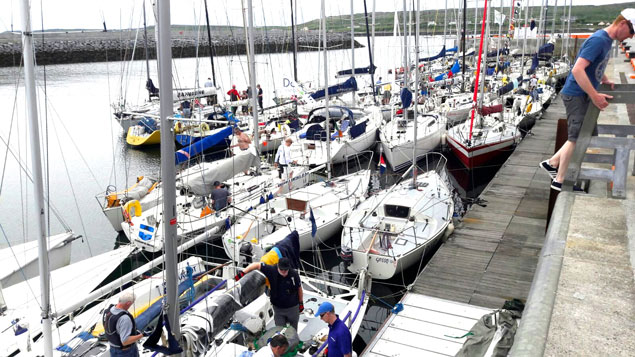 Packing them in. A week before the Drascombes arrived, the WIORA fleet had landed in on Kilronan big time
Packing them in. A week before the Drascombes arrived, the WIORA fleet had landed in on Kilronan big time
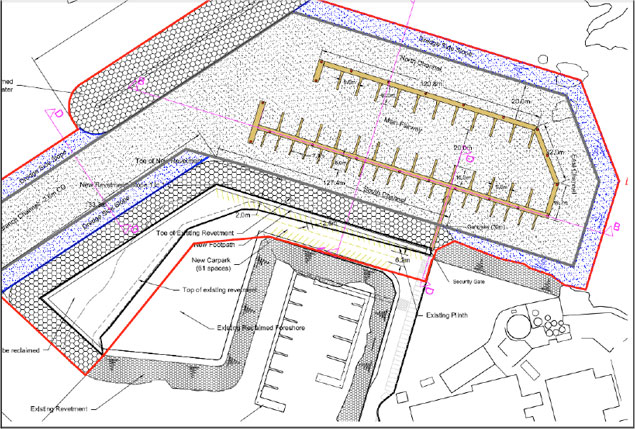 Meanwhile across on the mainland, the new marina at Rossaveal is nearing completion
Meanwhile across on the mainland, the new marina at Rossaveal is nearing completion
But while this is now almost completely in place, towards the head of Galway Bay the port of Galway itself is contemplating another expansion with marina facilities, while across the bay at Renville, as we’ve mentioned on Afloat.ie, Galway Bay SC has recently made a very clever job of improving its clubhouse, and it is surely only a matter of time before developments in waterfront berthing take place there too.
But the extra-special breakthrough which has best expressed the Spirit of the West has been the installation of the long L-shaped pontoon in the much-extended Kilronan Harbour on Inishmore, the largest of the Aran Islands. This was planned to be done in time for the mighty successful West of Ireland Offshore Racing Association Championship just over three weeks ago, and the new setup accommodated the 44-strong fleet in such style that a casual observer might gave though that this was all a permanent new fixture.
Certainly the way that the WIORA sailors partied for their après sailing there and in downtown Kilronan would if anything have reinforced such a view. Yet in theory those pontoons are just a temporary arrangement. And they were put there in a shared voluntary effort which would put some of our more hidebound maritime communities to shame for its sheer enthusiasm and energy.
Those who were promoting the Kilronan Berthing Project - not least WIORA Championship Organiser Cormac Mac Donncha – argued that with all of the new berthing capacity in the city and in Rossaveal, those boat owners would need somewhere to visit and berth safely. This is where the pontoon in Kilronan comes in, with the benefits going well beyond recreational sailing. The users will include the small ‘pot haulers’ owned by the local fishermen, commercial angling boats, commercial charter sailing yachts, visiting motor vessels, and yachts.
Galway County Council were very supportive of the project. Patrick McDonagh, Kilronan Harbour Master, provided supervision and advice throughout. Ciarán Wynne, Harbours Engineer, Galway Co Co, provided the promoters with the various permissions to go ahead with the project. The pontoon was installed by the voluntary effort of local business men and volunteers, in a heartening community spirit.
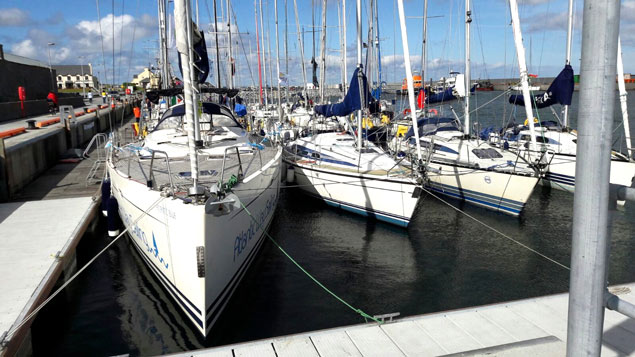 As soon as it was very competently installed, the new Kilronan pontoon had a fleet in port to show it at its best.
As soon as it was very competently installed, the new Kilronan pontoon had a fleet in port to show it at its best.
The pontoons themselves were supplied on loan by Inland & Coastal Marinas, based in Banagher on the Shannon. Iggy Madden Transport of Galway, provided the transport without charge. Galway Harbour Board supported the storage and crane operations at Galway Docks and Lasta Mara Teo transported the cargo to the Islands and dropped 16 mooring blocks. LM Keating installed the pier beams, and OceanCrest Marine supplied the special pontoon to H-Beam bracketry. ThermoKing, the Beatty family and Club Seoltóireacht Árainn provided the skilled crew to install the pontoons and make them safe.
Inland & Coastal has extended the loan of the pontoons so that the local committee can attempt to put a plan together to purchase and upgrade them to form a permanent facility. A very significant proportion of the project’s cost lies in the selection, transportation and installation of the pier beams and pontoons. Galway Co Co are working with the committee to try to find a funding solution to upgrade the existing ‘marina’. It has been recognised that, if the pontoons are returned to Inland & Coastal at this stage, then a large percentage of the cost will need to be duplicated in order to reinstate the marina at a later stage.
 A touch of the Med in Kilronan. WIORA even had St Pat’s Brass Band (left) to welcome them in.
A touch of the Med in Kilronan. WIORA even had St Pat’s Brass Band (left) to welcome them in.
So efforts to seek funding are currently underway. You just can’t see it not happening, and a longer term objective might be the installation of an access bridge, as the 5 metre tidal range can make that quay wall seem very high. Once the sportsmen and revellers of WIORA had gone on their way, there was ample and much-valued space for local boats of all type, and then a week later the Drascombe Association of Ireland arrived in a fleet from Roundstone in the midst of their week-long Galway Bay Cruise-in-Company. Even though a Drascombe can be hauled up a beach if need be, every last one of them was delighted with the convenience and comfort which the new pontoon provided.
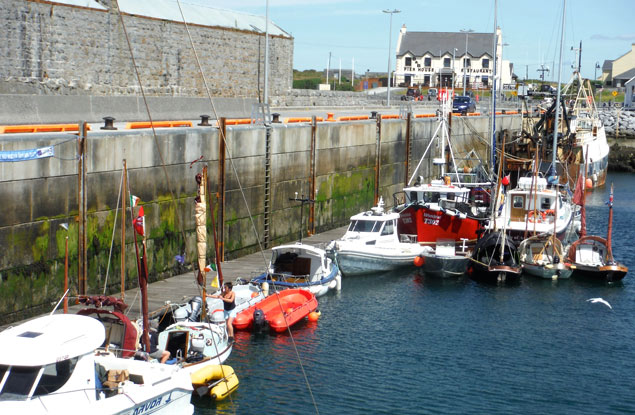 Drascombes and other boats at Kilronan pontoon – as convenient as possible for the pub. Photo: Jack O’Keeffe
Drascombes and other boats at Kilronan pontoon – as convenient as possible for the pub. Photo: Jack O’Keeffe
Seen from a go-anywhere Drascombe, Galway Bay becomes the cruising paradise its advocates have always insisted is there, waiting to be discovered. The Drascombes, co-ordinated by Jack OKeeffe of Cork and Brian Park of Limerick, had mustered at Kilkieran, and then cruised along the coast to Finnish Island before heading for Roundstone. Mac Dara’s island came up on the programme, and then there was an open water passage out to Kilronan and the luxury of a secure marina berth at the end of it.
They’d hope to cruise among the Aran Islands in detail, but the weather was going to pot and they decided to get on with the next stage of their programme. So as pre-arranged, the open boats headed back to Kilkieran and the cabin Drascombe boats made a passage across to Ballyvaughan in the foothills of The Burren in County Clare, which left them well-placed for detailed exploration to fresh places such as Leenane’s renowned seafood bar at New Quay, followed by the winding waterways of Bell Harbour.
Kinvara was a natural stopover port, and they finally brought it all to a successful conclusion back at Galway Bay SC at Renville, firmly convinced of the unique attractions of the greater Galway Bay area as a cruising ground, and one hundred per cent supportive of the notion that the new pontoons at Kilronan should be a permanent feature.



























